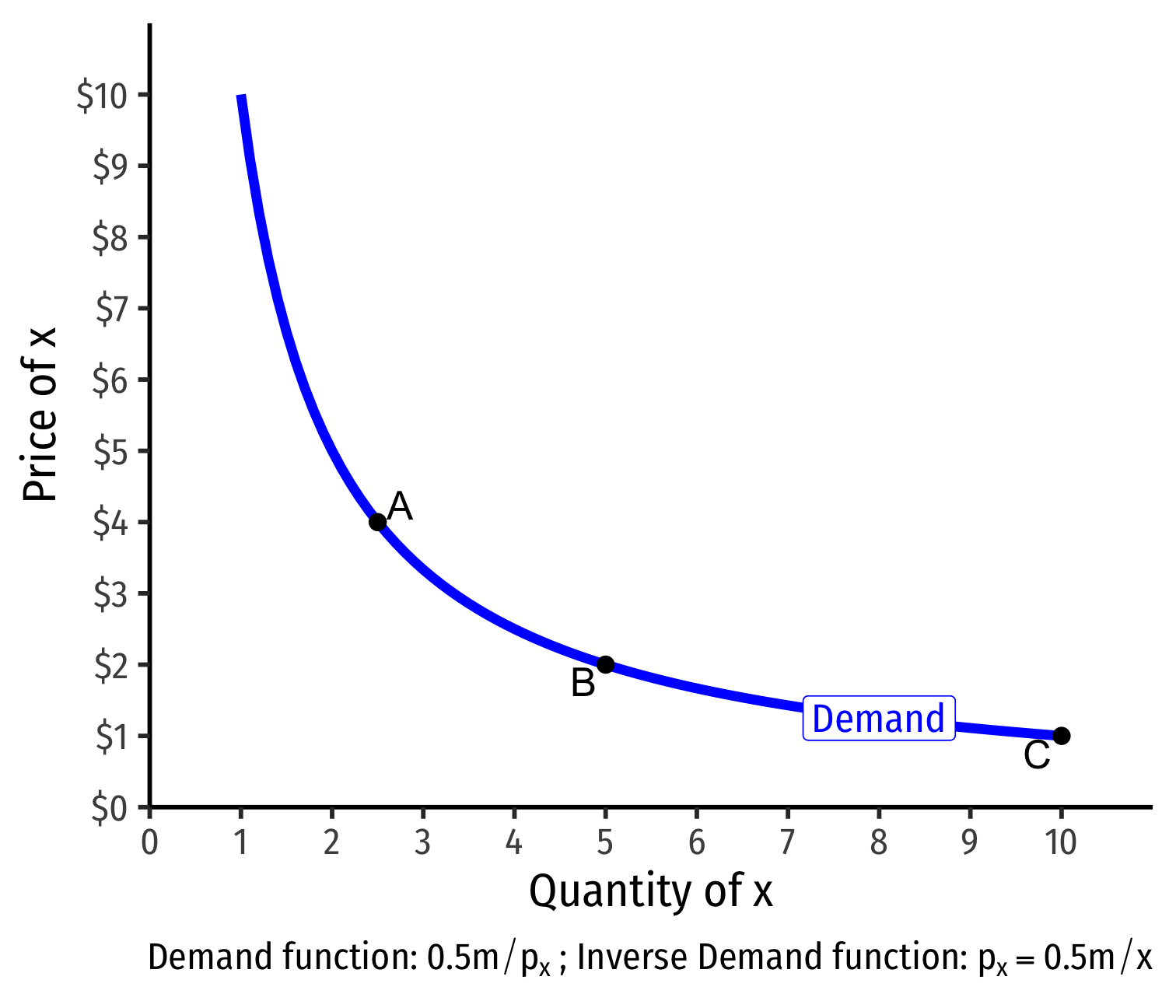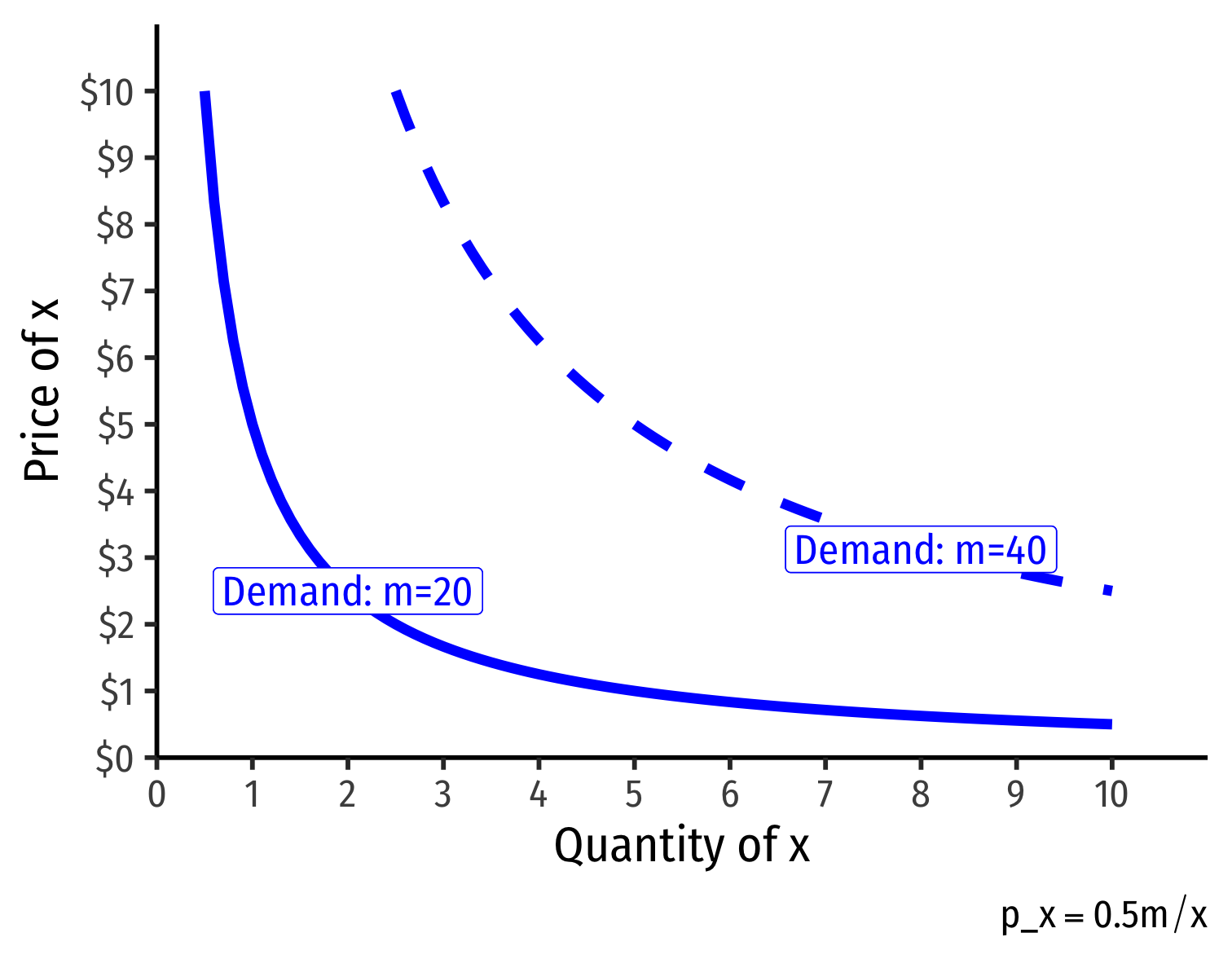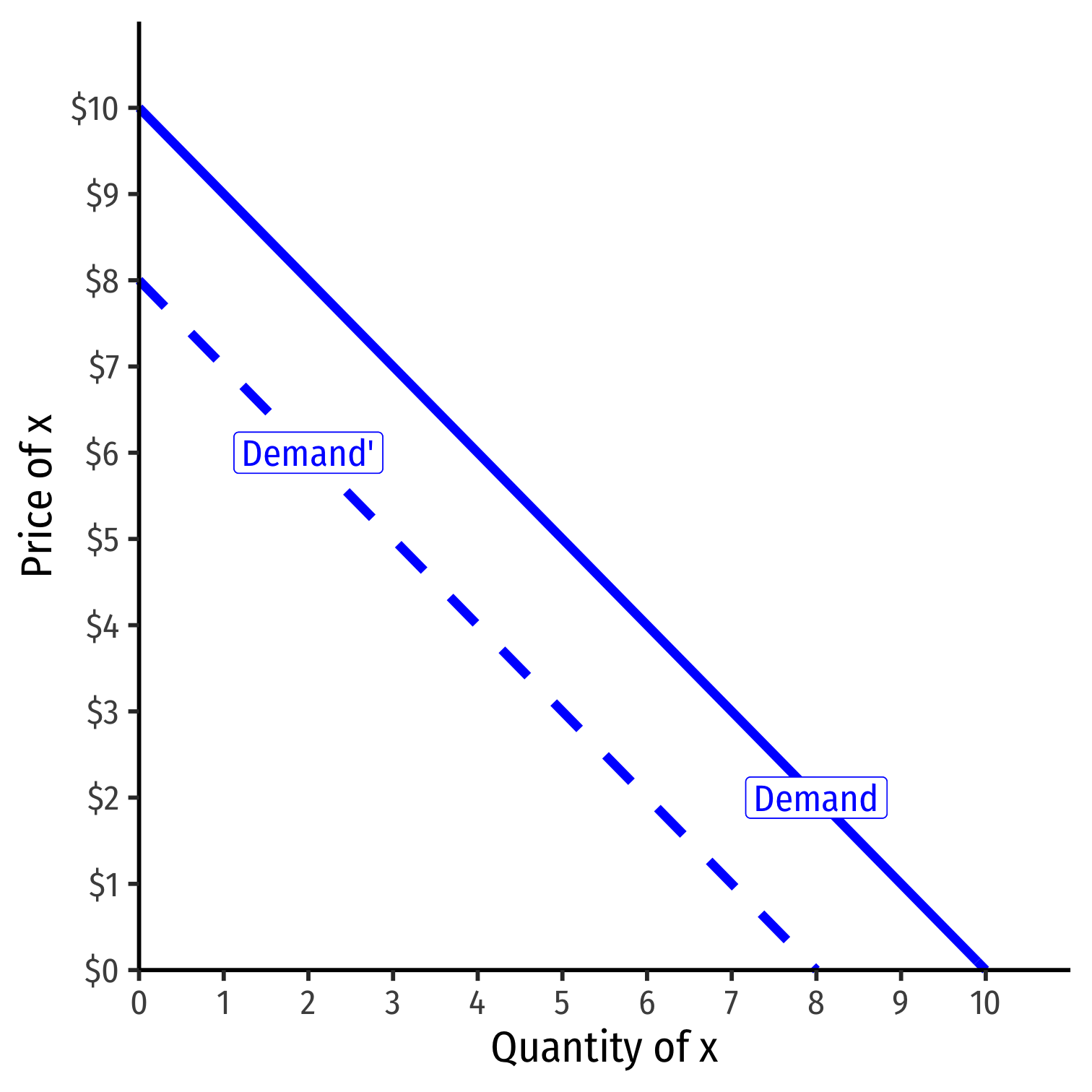1.8: Income and Substitution Effects
ECON 306 · Microeconomic Analysis · Fall 2019
Ryan Safner
Assistant Professor of Economics
safner@hood.edu
ryansafner/microf19
microF19.classes.ryansafner.com
A Demand Function (Again)
- A consumer's quantity demanded (of good x), qDx is a function of their demand for good x, which depends on current market prices and their income
qDx=D(m,px,py)
- We now want to examine how quantity demanded for x changes as each of these parameters change:
- Income effects (ΔqDxΔm): how qDx changes with changes in income
- Cross-price effects (ΔqDxΔpy): how qDx changes with changes in prices of other goods (e.g. y)
- (Own) Price effects (ΔqDxΔpx): how qDx changes with changes in price (of x)

The (Own) Price Effect
The (Own) Price Effect
- Price effect: change in optimal consumption of a good associated with a change in its price, holding income and other prices constant
ΔqDxΔpx<0
The law of demand: as the price of a good rises, people will tend to buy less of that good (and vice versa)
- i.e. the price effect is negative!

Decomposing the Price Effect
- The price effect (law of demand) is actually the net result of two effects
Decomposing the Price Effect
The price effect (law of demand) is actually the net result of two effects
(Real) income effect: change in consumption due to change in real purchasing power
Decomposing the Price Effect
The price effect (law of demand) is actually the net result of two effects
(Real) income effect: change in consumption due to change in real purchasing power
Substitution effect: change in consumption due to change in relative prices
Decomposing the Price Effect
The price effect (law of demand) is actually the net result of two effects
(Real) income effect: change in consumption due to change in real purchasing power
Substitution effect: change in consumption due to change in relative prices
Price Effect=Real income effect+Substitution Effect
(Real) Income Effect
(Real) Income Effect
Suppose there is only 1 good to consume, x. You have a $100 income, and the price of x is $10. You consume 10 units of x
Suppose the price of x falls to $5. Your now consume 20 units of x.
This is the real income effect: a change in the price of x changes your real income or purchasing power, the amount of goods you can buy
Note your actual (nominal) income of $100 never changed!

(Real) Income Effect: Size
The size of the income effect depends on how large a portion of your budget you spend on the good
Large-budget items:
- e.g. Housing/apartment rent, car prices
- Price increase makes you much poorer
- Price decrease makes you much wealthier
Small-budget items:
- e.g. pencils, toothpicks, candy
- Price changes don't have much of an effect on your wealth or change your behavior much


Substitution Effect
Substitution Effect
Suppose there are 1000s of goods, none of them are a major fraction of your budget
Suppose the price of one good, x increases
The real income effect for x is tiny (and negative)
But you would consume less of x relative to other goods because x is now relatively more expensive
That's the substitution effect: consumption changes because of a change in relative prices

Substitution Effect: Size
- The size of the substitution effect depends on how substitutable two goods are

- Straighter → more substitutable
Substitution Effect: Size
- The size of the substitution effect depends on how substitutable two goods are

- Straighter → more substitutable

- Curved → more complementary
Putting the Effects Together
Putting the Effects Together
- Real income effect: change in consumption due to change in real purchasing power
- Can be positive (normal goods) or negative (inferior goods)
- Lower price of x means you can buy more x, y, or both (depending on your preferences between x and y)
Putting the Effects Together
- Real income effect: change in consumption due to change in real purchasing power
- Can be positive (normal goods) or negative (inferior goods)
- Lower price of x means you can buy more x, y, or both (depending on your preferences between x and y)
- Substitution effect: change in consumption due to change in relative prices
- If x gets cheaper relative to y, consume ↓y (and ↑x)
- This is always the same direction! (↓ relatively expensive goods, uparrow relatively cheaper goods)
- This is why demand curves slope downwards!
Putting the Effects Together
- Real income effect: change in consumption due to change in real purchasing power
- Can be positive (normal goods) or negative (inferior goods)
- Lower price of x means you can buy more x, y, or both (depending on your preferences between x and y)
- Substitution effect: change in consumption due to change in relative prices
- If x gets cheaper relative to y, consume ↓y (and ↑x)
- This is always the same direction! (↓ relatively expensive goods, uparrow relatively cheaper goods)
- This is why demand curves slope downwards!
Price Effect=Real income effect+Substitution Effect
Real Income and Substitution Effects, Graphically I
- Original optimal consumption (A)

Real Income and Substitution Effects, Graphically I
Original optimal consumption (A)
(Total) price effect: A→C
Let's decompose this into the two effects

Real Income and Substitution Effects, Graphically II
- Substitution effect: what would have been chosen at the new price ratio to remain indifferent as before

Real Income and Substitution Effects, Graphically II
Substitution effect: what would have been chosen at the new price ratio to remain indifferent as before
Graphically: shift new budget constraint inwards until tangent with old indifference curve
A→B on same I.C. (↑ cheaper x and ↓ y)
- Note it must be a different point on the original curve!

Real Income and Substitution Effects, Graphically II
Substitution effect: what would have been chosen at the new price ratio to remain indifferent as before
Graphically: shift new budget constraint inwards until tangent with old indifference curve
A→B on same I.C. (↑ cheaper x and ↓ y)
- Note it must be a different point on the original curve!

Real Income and Substitution Effects, Graphically III
- (Real) income effect: change in quantities consumed due to the change in purchasing power after the change in price

Real Income and Substitution Effects, Graphically III
(Real) income effect: change in quantities consumed due to the change in purchasing power after the change in price
B→C to new budget constraint (can buy more of x and/or y)

Real Income and Substitution Effects, Graphically III
(Real) income effect: change in quantities consumed due to the change in purchasing power after the change in price
B→C to new budget constraint (can buy more of x and/or y)

Real Income and Substitution Effects, Graphically IV
- Original optimal consumption (A)

Real Income and Substitution Effects, Graphically IV
Original optimal consumption (A)
Price of x falls, new optimal consumption at (C)

Real Income and Substitution Effects, Graphically IV
Original optimal consumption (A)
Price of x falls, new optimal consumption at (C)
Substitution effect: A→B on same I.C. (↑ cheaper x and ↓ y)

Real Income and Substitution Effects, Graphically IV
Original optimal consumption (A)
Price of x falls, new optimal consumption at (C)
Substitution effect: A→B on same I.C. (↑ cheaper x and ↓ y)
(Real) income effect: B→C to new budget constraint (can buy more of x and/or y)

Real Income and Substitution Effects, Graphically IV
Original optimal consumption (A)
Price of x falls, new optimal consumption at (C)
Substitution effect: A→B on same I.C. (↑ cheaper x and ↓ y)
(Real) income effect: B→C to new budget constraint (can buy more of x and/or y)
(Total) price effect: A→C

Real Income and Substitution Effects: Inferior Good
- What about for an inferior good (like Ramen)?

Real Income and Substitution Effects: Inferior Good
What about for an inferior good (like Ramen)?
Substitution effect: A→B on same I.C. (↑ cheaper x and ↓ y)

Real Income and Substitution Effects: Inferior Good
What about for an inferior good (like Ramen)?
Substitution effect: A→B on same I.C. (↑ cheaper x and ↓ y)
(Real) income effect: B→C to new budget constraint (can buy more of x and/or y)

Real Income and Substitution Effects: Inferior Good
What about for an inferior good (like Ramen)?
Substitution effect: A→B on same I.C. (↑ cheaper x and ↓ y)
(Real) income effect: B→C to new budget constraint (can buy more of x and/or y)
(Total) price effect: A→C

Real Income and Substitution Effects: Inferior Good
What about for an inferior good (like Ramen)?
Substitution effect: A→B on same I.C. (↑ cheaper x and ↓ y)
(Real) income effect: B→C to new budget constraint (can buy more of x and/or y)
(Total) price effect: A→C
Price effect is still an ↑x from a ↓px!
- Person would just prefer to spend more new purchasing power on other goods (y)!
The law of demand holds, even for inferior goods!
- Because subst. effect dominates real income effect

Violating the Law of Demand
Example: What would it take to violate the law of demand?
Recap: Real Income and Substitution Effects
Substitution Effect+Real Income Effect=Price Effect
Substitution effect: is always in the direction of the cheaper good
Real Income effect: can be positive (normal) or negative *inferior)
Law of Demand/Demand curves slope downwards (Price effect) mostly because of the substitution effect
- Even (inferior) goods with negative real income effects overpowered by substitution effect
Exception in the theoretical Giffen good: negative R.I.E. > S.E.
- An upward sloping demand curve!
From Optimal Consumption Points to Demand
Demand Schedule
Demand schedule expresses the quantity of good a person would be willing to buy (qD) at any given price (px)
Note: each of these is a consumer's optimum at a given price!
| price | quantity |
|---|---|
| 10 | 0 |
| 9 | 1 |
| 8 | 2 |
| 7 | 3 |
| 6 | 4 |
| 5 | 5 |
| 4 | 6 |
| 3 | 7 |
| 8 | 2 |
| 9 | 1 |
| 10 | 0 |
Demand Curve
Demand curve graphically represents the demand schedule
Also measures a person's maximum willingness to pay (WTP) for a given quantity
Law of Demand (price effect) ⟹ Demand curves always slope downwards

Demand Function
- Demand function relates quantity to price
Example: q=10−p
- Not graphable (wrong axes)!

Inverse Demand Function
- Inverse demand function relates price to quantity
- Find by taking demand function and solving for p
Example: p=10−q
- Graphable (price on vertical axis)!
Inverse Demand Function
- Inverse demand function relates price to quantity
- Find by taking demand function and solving for p
Example: p=10−q
Graphable (price on vertical axis)!
Slope: −1
Vertical intercept called the "Choke price": price where qD=0 ($10), just high enough to discourage any purchases

Inverse Demand Function
- Inverse demand function relates price to quantity
- Find by taking demand function and solving for p
Example: p=10−q
Read two ways:
Horizontally: at any given price, how many units person wants to buy
Vertically: at any given quantity, the maximum willingness to pay (WTP) for that quantity
- This way will be very useful later

Deriving a Demand Curve Graphically


- Demand curve for x relates consumer's optimal consumption of x ("quantity") as price of x changes
- At px=4, consumer buys 2 x
Deriving a Demand Curve Graphically


- Demand curve for x relates consumer's optimal consumption of x ("quantity") as price of x changes
- At px=4, consumer buys 2 x; at px=2, consumer buys 5 x
Deriving a Demand Curve Graphically


- Demand curve for x relates consumer's optimal consumption of x ("quantity") as price of x changes
- At px=4, consumer buys 2 x; at px=2, consumer buys 5 x; at px=1, consumer buys 10 x
Deriving a Demand Curve Graphically


- Demand curve for x relates consumer's optimal consumption of x ("quantity") as price of x changes
- At px=4, consumer buys 2 x; at px=2, consumer buys 5 x; at px=1, consumer buys 10 x
Deriving a Demand Function I
I will always give you a (linear) demand function
Today's class notes page shows how you can derive actual demand functions from utility functions
Deriving a Demand Function II
MATH FYI: for a Cobb-Douglas utility function (where the two exponents sum to 1): u(x,y)=xay(1−a)
the demand function for x is qx=ampx
Property 1: Consumer always spends proportion a of their total income on x!
Ptroperty 2: demand for x is unaffected by prices of other goods (no py anywhere)!
To get a demand function just in terms of price, input a given income.
Deriving a Demand Function III
Example: u(x,y)=x0.5y0.5, demand function is
qx=0.5mpx
Always spend 50% (a) of income on x
With an income of m=10 Demand: qx=5pxInv. demand: px=5qx
With an income of m=50 Demand: qx=25pxInv. demand: px=25qx

Shifts in Demand I
- Note a simple (inverse) demand function only relates (own) price and quantity
Example: q=10−p or p=10−q
What about all the other "determinants of demand" like income and other prices?
They are captured in the vertical intercept (choke price)!

Shifts in Demand I
- Note a simple (inverse) demand function only relates (own) price and quantity
Example: q=10−p or p=10−q
What about all the other "determinants of demand" like income and other prices?
They are captured in the vertical intercept (choke price)!

Shifts in Demand II
A change in one of the "determinants of demand" (or "shifters") will shift the demand curve
- Change in income m
- Change in price of other goods py (substitutes or complements)
- Change in preferences or expectations about good x (show up in utility function)
- Change in number of buyers in market
Shows up in (inverse) demand function by a change in the intercept (choke price)!
See my Visualizing Demand Shifters
